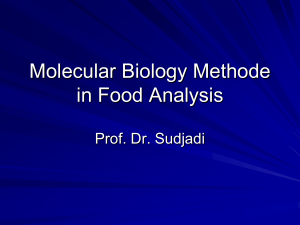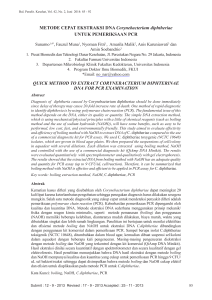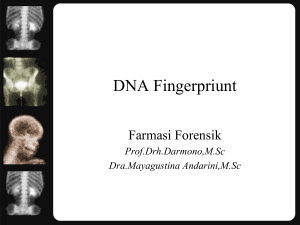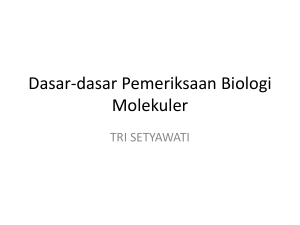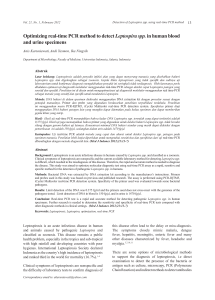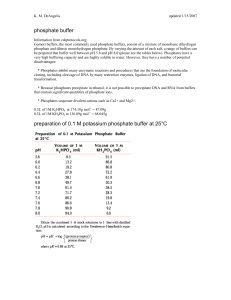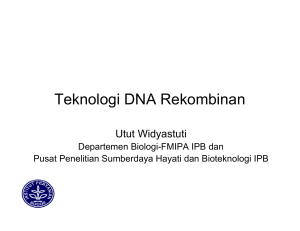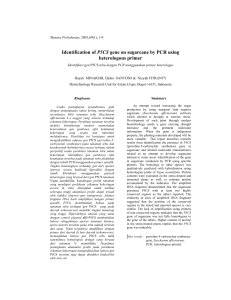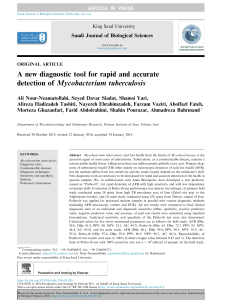COMPARATIVE EVALUATION OF CONVENTIONAL VERSUS
advertisement
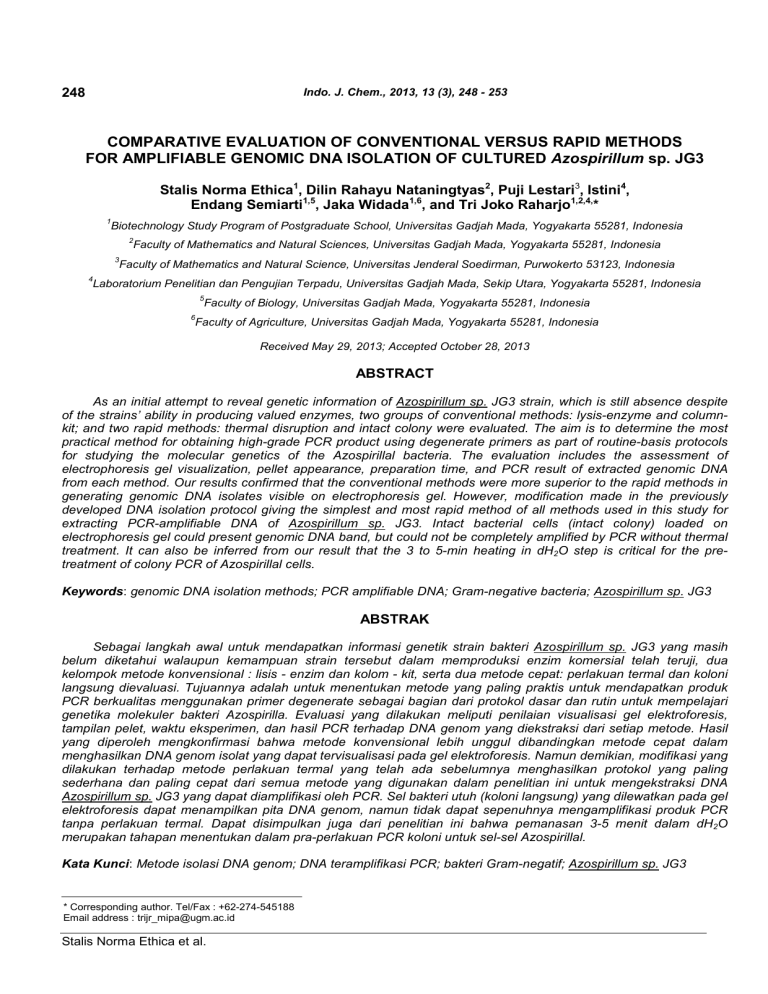
248 Indo. J. Chem., 2013, 13 (3), 248 - 253 COMPARATIVE EVALUATION OF CONVENTIONAL VERSUS RAPID METHODS FOR AMPLIFIABLE GENOMIC DNA ISOLATION OF CULTURED Azospirillum sp. JG3 Stalis Norma Ethica1, Dilin Rahayu Nataningtyas2, Puji Lestari3, Istini4, Endang Semiarti1,5, Jaka Widada1,6, and Tri Joko Raharjo1,2,4,* 1 Biotechnology Study Program of Postgraduate School, Universitas Gadjah Mada, Yogyakarta 55281, Indonesia 2 3 4 Faculty of Mathematics and Natural Sciences, Universitas Gadjah Mada, Yogyakarta 55281, Indonesia Faculty of Mathematics and Natural Science, Universitas Jenderal Soedirman, Purwokerto 53123, Indonesia Laboratorium Penelitian dan Pengujian Terpadu, Universitas Gadjah Mada, Sekip Utara, Yogyakarta 55281, Indonesia 5 6 Faculty of Biology, Universitas Gadjah Mada, Yogyakarta 55281, Indonesia Faculty of Agriculture, Universitas Gadjah Mada, Yogyakarta 55281, Indonesia Received May 29, 2013; Accepted October 28, 2013 ABSTRACT As an initial attempt to reveal genetic information of Azospirillum sp. JG3 strain, which is still absence despite of the strains’ ability in producing valued enzymes, two groups of conventional methods: lysis-enzyme and columnkit; and two rapid methods: thermal disruption and intact colony were evaluated. The aim is to determine the most practical method for obtaining high-grade PCR product using degenerate primers as part of routine-basis protocols for studying the molecular genetics of the Azospirillal bacteria. The evaluation includes the assessment of electrophoresis gel visualization, pellet appearance, preparation time, and PCR result of extracted genomic DNA from each method. Our results confirmed that the conventional methods were more superior to the rapid methods in generating genomic DNA isolates visible on electrophoresis gel. However, modification made in the previously developed DNA isolation protocol giving the simplest and most rapid method of all methods used in this study for extracting PCR-amplifiable DNA of Azospirillum sp. JG3. Intact bacterial cells (intact colony) loaded on electrophoresis gel could present genomic DNA band, but could not be completely amplified by PCR without thermal treatment. It can also be inferred from our result that the 3 to 5-min heating in dH2O step is critical for the pretreatment of colony PCR of Azospirillal cells. Keywords: genomic DNA isolation methods; PCR amplifiable DNA; Gram-negative bacteria; Azospirillum sp. JG3 ABSTRAK Sebagai langkah awal untuk mendapatkan informasi genetik strain bakteri Azospirillum sp. JG3 yang masih belum diketahui walaupun kemampuan strain tersebut dalam memproduksi enzim komersial telah teruji, dua kelompok metode konvensional : lisis - enzim dan kolom - kit, serta dua metode cepat: perlakuan termal dan koloni langsung dievaluasi. Tujuannya adalah untuk menentukan metode yang paling praktis untuk mendapatkan produk PCR berkualitas menggunakan primer degenerate sebagai bagian dari protokol dasar dan rutin untuk mempelajari genetika molekuler bakteri Azospirilla. Evaluasi yang dilakukan meliputi penilaian visualisasi gel elektroforesis, tampilan pelet, waktu eksperimen, dan hasil PCR terhadap DNA genom yang diekstraksi dari setiap metode. Hasil yang diperoleh mengkonfirmasi bahwa metode konvensional lebih unggul dibandingkan metode cepat dalam menghasilkan DNA genom isolat yang dapat tervisualisasi pada gel elektroforesis. Namun demikian, modifikasi yang dilakukan terhadap metode perlakuan termal yang telah ada sebelumnya menghasilkan protokol yang paling sederhana dan paling cepat dari semua metode yang digunakan dalam penelitian ini untuk mengekstraksi DNA Azospirillum sp. JG3 yang dapat diamplifikasi oleh PCR. Sel bakteri utuh (koloni langsung) yang dilewatkan pada gel elektroforesis dapat menampilkan pita DNA genom, namun tidak dapat sepenuhnya mengamplifikasi produk PCR tanpa perlakuan termal. Dapat disimpulkan juga dari penelitian ini bahwa pemanasan 3-5 menit dalam dH2O merupakan tahapan menentukan dalam pra-perlakuan PCR koloni untuk sel-sel Azospirillal. Kata Kunci: Metode isolasi DNA genom; DNA teramplifikasi PCR; bakteri Gram-negatif; Azospirillum sp. JG3 * Corresponding author. Tel/Fax : +62-274-545188 Email address : [email protected] Stalis Norma Ethica et al. Indo. J. Chem., 2013, 13 (3), 248 - 253 INTRODUCTION DNA isolation is a routine step in many biological studies including molecular identification, phylogenetic inference, genetics and genomics [1]. Numerous genomic DNA extraction methods for microbia have been developed considering the nature of cell wall [2-8], but most of these methods are less practical due to safety, cost, duration, complexity, and non-universality issues. Meanwhile, many DNA extraction kits are commercially available [1]; the uses of these kits for DNA extraction of cultured bacteria have been widely applied [7,9]. Conventional methods for genomic bacterial DNA extraction rely primarily on chemical lysis using lysozyme in conjunction with other lipolytic and protolytic enzymes and a series of extraction prior to precipitation of the nucleic acids [2,4-5,8]. Nevertheless, chemical lysis is restricted to certain sample types and properties, thus lacking universality [10]. Due to the nature of bacterial cell wall, some bacteria showed reduced susceptibility to lyzozyme, while some others were even resistant to the enzyme [2]. On the other hand, rapid methods focusing on cell disruption without the need of extensive chemical procedure have great potential for automated applications in DNA analysis. Speed of procedure is among determinants of the best DNA extraction method as well as other considerations such as sample number, i.e. the degree of parallelization, and sample scale [10]. DNA extraction methods for cultured Gramnegative bacteria commonly use specific treatments such as enzyme incubation [11], lysis buffer extraction [4,12], silica-resin kit application [9], bead beating and freeze thawing [13], and electric field pulsing [10]. Interestingly, an intact colony method using bacterial cells directly for PCR was reported successful for probiotic Lactobacillus strain in fecal samples [14]. A DNA extraction short protocol based on direct cell disruption method for Azospirillum with specific gene primers [15- and 20-mer oligonucleotides] was proven to work quite well, although it failed to give reliable profiles when using the random decanucleotide primers for RAPD technique [6,15]. Improved methods by thermal disruption requiring no extra purification step was found to be suitable for RAPD experiments [6]. Nearly similar method but requiring dilution for methanotropic bacteria was published [16]. Yet, there has been no evaluation comparing all of these methods referring the most critical step to isolate genomic DNA for PCR experiments of Azospirillum sp. strains in regular basis. Among the most examined plant growth-promoting bacteria [PGPB], Azospirillum strains have gained commercialization in several countries including Argentina, Mexico, Italy, India, and France [17-18]. Aside Stalis Norma Ethica et al. 249 of being beneficial as soil fertilizer, these bacteria have potential use in solving environment problems such as assisting reforestation efforts of severely eroded lands, restoration of marine mangrove ecosystems, phytostabilization of mine tailings, assisting in metal and pesticide decontamination of soils and biological treatment of wastewater [18]. In particular, strain Azospirillum sp. JG3 has ability to produce lipase and amylase as recently reported [19-20]. To study the molecular genetics of strain Azospirillum sp. JG3 in a routine basis the most practical method that can be used with high extraction efficiency should be evaluated. The aim of this study was to compare different methods for Gram-negative bacteria based on different principles i.e. lysis-enzyme, column-kit, thermal disruption and intact colony to obtain PCR amplifiable genomic DNA of strain Azospirillum sp. JG3. The total DNA isolated using these protocols were assessed in terms of gel electrophoresis visualization, pellet appearance, preparation time, and PCR amplification results using degenerate primers. EXPERIMENTAL SECTION Materials Azospirillum sp. JG3 bacterial samples were collected from Microbiology Laboratory, Faculty of Biology, Universitas Jenderal Soedirman, Purwokerto, Indonesia as a generous gift. RNAse free water (Gibco TM), forward and reverse degenerate primers (GKF 5’GGYCACRTCCTCGCCATC-3’ and GKR 5’-ACATGGT CGAKRATCCAGG-3’), illustraTM Ready To Go PCR ® bead (GE Healthcare), Geneaid DNA Mini Kit for cultured Gram-negative bacteria, dH2O (Merck), agarose (Invitrogen), TAE buffer, 6x loading buffer (Vivantis), ethidium bromide (EB) (Invitrogen), DNA marker (Invitrogen), tris base (Merck), acetic acid glacial (Merck), EDTA (Merck) pH 8, sterile aquadest (LPPT). Instrumentation The instruments used in this study were SigmaAldrich instant nutrient agar and nutrient broth, Denver AA-250 digital balance, Nuaire laminar flow, Olympus light microscope, Hiramaya HL 36 AE autoclave, Barnstead vortex, OSK Seiwa Reiko water bath incubator, Sorvall Biofuge centrifugator, Bio Rad Thermal cycler PCR, Gilson micro pipettes, Sanyo microwave, Shimadzu Probe UV-Vis Spectrophotometer, Bio Rad [Wide Minisub[R] cell GT] electrophoresis, Bio-Rad UV lamp, and DSLR Kodak camera. 250 Indo. J. Chem., 2013, 13 (3), 248 - 253 Procedure Cultivation of bacteria The strains were allowed to grow 24 h at 37 °C in plates containing 28 g/L instant nutrient agar and tubes containing 13 g/L nutrient broth. The morphology of grown bacteria was observed under light microscope and fresh bacterial suspension with DO600=1 was checked using UV-Vis spectroscopy. DNA extraction Several fresh and visible colonies of Azospirillum sp. JG3 on agar media and 9.5 mL of the bacterial cell suspension with DO600=1 were used to prepare DNA templates for PCR using four different procedures consisting of two conventional methods [lysis-enzyme and column-kit] and rapid methods (thermal disruption and intact-colony). For lysis-enzyme procedure 8 mL of fresh bacterial suspension was prepared and then treated according to previous study [5]. For column-kit protocol 1.5 mL of bacterial suspension was used following the instructions of the kit manufacturer [21]. To perform thermal disruption method a loopful of colonies [visible] from agar culture was picked using a sterile tip of a Gilson P20 automatic pipettor and the cells adhering to the tip were directly dispersed in 8 μL dH2O followed by heating at 95 °C for 3-5 min as a modification from previous method [6] and left to cool at room temperature. Similar amount of colonies from agar culture was directly used as the DNA template for intact-colony PCR, as reported earlier [14-15]. To calculate the concentration of genomic DNA isolates obtained from both conventional methods to be used as PCR templates absorbance at 260 nm was measured using a UV-Vis Spectrophotometer. When assessing preparation time of each method, time required for preparing reagents, bacterial culture and cell suspension was not counted. PCR amplification For PCR amplification a pair of forward and reverse degenerate primers (GKF 5’-GGYCACRTCCTCGCC ATC-3’ and GKR 5’-ACATGGTCGAKRATCCAGG-3’) was designed from glycerol kinase gene sequence set of Azospirillum genus. A mixture containing an iLLustra™ puReTaq Ready-To-Go PCR bead, 25 pmol of forward and 25 pmol of reverse primers respectively were added into each of four PCR tubes to perform PCR. DNA templates for every of these PCR tubes are as follows: 50 ng of DNA isolate from lysis-enzyme method, 50 ng of DNA isolate from column kit, 8 μL bacterial isolate from thermal disruption method, and a loopful of intact colonies from solid culture. PCR-grade water was added to give a total volume of 25 μL for each tube. PCR amplification was performed in a thermal cycler (BioRad, Germany) with an initial hot start at 95ºC for 5 min Stalis Norma Ethica et al. followed by 35 cycles of denaturation at 95 °C for 1 min, annealing at 53 °C for 35 min, polymerization at 72 °C for 45 min and a final elongation at 72 °C for 7 min. Gel electrophoresis 10 µL of each DNA isolate from four different methods and 10 µL of each associated PCR products were loaded on 1.8% agarose gel with 0.5x TAE running buffer and 6x loading buffer stained with 0.25 μg/mL ethidium bromide at 50 volts for 40 min for visualization. The sizes of DNA were estimated using the DNA marker. A digital image was taken using a DSLR camera. RESULT AND DISCUSSION Bacterial Growth Bacterial samples used in this study were wellgrown indicated by the observed white pellicle formation and rod shape appearance as the typical morphology characteristic of colonies and cells of Azospirillum respectively [22]. The living cells of Azospirillum sp. JG3 examined under the light microscope are shown by Fig. 1. Fresh bacterial suspension with DO600=1 was obtained. DNA Extraction During the preparation of bacterial genomic DNA the precipitated DNA pellets were only resulted by the lysis-enzyme with clear to white appearance, while no pellet was generated by three other methods. Although various DNA extraction methods result in different color of pellet, this does not indicate protein contamination level [1]. DNA isolates of bacterial cells using four methods were visualized on the electrophoresis gel as shown in Fig. 2. Both conventional methods used in this research produced genomic DNA bands around 4 kbp, while simple methods showed different results. The cells treated with thermal disruption did not present any visualization of genomic DNA on gel, but showing instead big trace of large size DNA in its load well. Contrariwise, intact bacterial cells in dH2O were able to present such ~4-kbp single DNA band. Two additional bands observed aside of the genomic band from lysis-enzyme method were an indication of the presence of bacterial RNA, which did not appear in extracted DNA from column-kit method. Although purity is likely minor interest in obtaining PCR amplifiable genomic DNA due to the availability of several excellent DNA purification systems [10], it was proven that the column-kit method had already Indo. J. Chem., 2013, 13 (3), 248 - 253 Fig 1. Cells of Azospirillum sp. JG3 observed under an optic microscope Fig 2. Comparison of Azospirillum sp. JG3 genomic DNA isolates from four different methods (left) and their related PCR products (right). 1.8% agarose gel electrophoresis of genomic DNA isolates from lysis enzyme method (lane 1); column-kit method (lane 2); thermal disruption method (lane 3); intact colony method (lane 4); 100-bp DNA ladder size marker (M); Amplified PCR products using genomic DNA from lysis-enzyme method (lane 5); column-kit method (lane 6); thermal disruption method (lane7); and intact colony method (lane 8) purification system included, which was able to satisfactorily remove RNA impurities from DNA isolate. Similarly the result from intact colony did not show bands of RNA impurities either although obviously this method did not use any purification system. However, it is very likely that the diluted cells still contained RNA molecules although for some reasons these molecules were not detected by electrophoresis gel. PCR Amplification Using our degenerate primers, genomic DNA samples extracted from all conventional methods used in Stalis Norma Ethica et al. 251 this study could be amplified by PCR while those from the rapid methods again showed different results. PCR results from lysis-enzyme, column-kit, and thermal disruptions methods successfully amplified DNA with sizes of 800 and 600 bp with decent DNA band intensity. Nevertheless, intact-colony method was not able to produce such high-grade PCR result but could only perform partial amplification of 600 bp DNA band instead. A longer initial hot-start step in PCR at 95 °C for 10 min led to even poorer result (data not shown) and this was likely due to improper temperature condition for polymerase enzyme to work. Various versions of colony PCR protocols have been developed for microbial cells that are basically differed on the use of centrifugation, extraction buffer, vortex, cell suspension, heating, and cooling [6,1415,23-25]. Interestingly, changes in these steps highly affect PCR results and this is likely related with the varied nature and components of microbial cell membranes. For example, Espinosa et al. (2013) tried two colony PCR protocols consisting of lightly touching a Gram-positive bacterial colony of a culture on blood agar with a sterile pipette tip and dispersing the collected cells into a tube containing 50 μL of nucleasefree water. The first mixture that was subjected to boiling at 100 °C for 5 min, subsequently frozen at -20 °C for 10 min, and centrifuged at 3000 g for 10 min gave successful PCR result, while the second, which was preheated at 95 °C for 10 min in the thermal cycler and then cooled failed [23]. Joshi et al. (1991) used E.coli and Salmonella typhimurium cells from solid cultures directly, for PCR without any boiling/ heating that proved to work quite well with specific gene primers (15- and 20-mer oligonucleotides), but failed to give reliable profiles for Azospirillum brasilense sample when using the random decanucleotide primers utilized in the RAPD technique [6,15]. Wan et al. (2011) developed a colony PCR procedure with centrifugation, re-suspension, extraction buffer incubation, and heating at 100 °C for genetic screening of Chlorella and related microalgae [24]. Quite similar to the work of Joshi et al. (1991), Lucchini et al. (1998) and Sheu et al. (2000) used 1 mm in diameter of colonies of Lactobacillus gasseri and polyhydroxyalkanoate-positive bacterial strains respectively, picked up with a sterilized toothpick and directly transferred to the PCR tubes [14,25]. Unfortunately, all of these cell protocols failed to give satisfying PCR results for our bacterial cells using 20-mer degenerate oligonucleotides. For Azospirillal samples, the use colony PCR with thermal disruption is much more economical compared to conventional PCR with conventionally extracted genomic DNA. Pedraza and Ricci (2004) successfully used boiling and room-temperature cooling for 252 Indo. J. Chem., 2013, 13 (3), 248 - 253 Table 1. Evaluated Parameters Comparing Different Genomic DNA Isolation methods of Azospirillum sp. JG3 Evaluated parameter Genomic DNA visualization Preparation time (min) Pellet appearance PCR-product quality Minimum initial bacterial sample Use of colony dilution/cell suspension Use of filtration Use of boiling/heating/freezing Use of toxic solvents (chloroform, phenol, etc) 1 Lysis-enzyme visible 150 clear to white high grade pellet from 8 mL suspension 2 3 4 Column-kit visible 30 – high grade Thermal disruption not visible 15 – high grade 1.5 mL suspension several colonies several colonies √ √ – – – √ √ √ – √ – – – – √ 1-3 – Tests had been carried out in duplicate. Reference of each method: Adopted from Moore et al. (2004), Adopted from Geneaid® DNA Mini Kit Manual for Cultured Cell 2013, 3Our modified method introducing shorter heating step than that in previous method of Pedraza et al. (2004), 4 Adopted from Joshi et al. (1991) and Lucchini et al. (1997). Azospirillal colony PCR of RAPD study using randomsequence 10-mer primers [6]. In order to make the protocol shorter we modified the aforementioned colony PCR method using our Azospirillal cells by introducing direct suspension and shorter boiling/ heating steps. Such modification gave the shortest protocol without reducing the quality of PCR result as displayed by Fig. 1 (lane 7). We found that shorter boiling time of 3 to 5 min (as compared to 10 min) is adequate for successful colony PCR of our sample but cannot be eliminated (data comparing these results are not shown). All conventional methods used here produced positive visibility of extracted DNA on gel and high grade PCR results, while not all the rapid methods could give the same. Similar to what was reported as “failed” by previous RAPD study of Azospirillum sp. [6] intact colony method using our primers was only able to produce sign of partial amplification from Azospirillal genomic DNA. In addition, visibility of extracted genomic DNA obtained using rapid methods was not a guarantee of high-grade PCR results. However, of all methods that led to successful PCR amplification, the thermal disruption method belonged to rapid method group required the least time without specific treatment or reagent to prepare the genomic DNA, while the lysis enzyme belonged to conventional method group needed the longest processing time. Due to the expensive enzymes used and high initial sample required, the lysis-enzyme is also considered as the costliest method though it provided the highest genomic DNA yield that was seen on electrophoresis gel as band with the highest intensity. Summary of all analyzed parameters evaluated in this study is shown by Table 1. We noted that as long as the colonies used were from freshly overnight culture, high-grade PCR results could be expected from the thermal disruption method used in our study. Older culture tended to give poor and even no PCR amplification (data not shown). In addition, it appeared from PCR results that adequate physical Stalis Norma Ethica et al. 1 Intact colony visible 1 – low grade 2 disruption of Azospirillal cell wall was the minimum requirement for successful PCR amplification of the bacterial genomic DNA. CONCLUSION In terms of the electrophoresis gel visibility of extracted genomic DNA, conventional methods were more superior to rapid methods in providing seeable results. However, above all methods used in this study, our thermal disruption method could be the simplest protocol to obtain high-grade PCR product from Azospirillum sp. JG3 using degenerate primers, although the extracted DNA from this method could not be confirmed on electrophoresis gel. It can be inferred from our result that the 3 to 5 min pre-heating/ boiling at 95 °C is the critical step for successful colony PCR of Azospirillal cells. ACKNOWLEDGEMENT We thank Oedjijono from Faculty of Biology, Universitas Jenderal Soedirman, Purwokerto Indonesia, for providing us strain Azospirillum sp. JG3 sample. We also thank Budi Setyadi Leonanta from PT Genetika Science Indonesia for giving sample of ® Geneaid DNA Mini Kit used in this study. REFERENCES 1. Chen, H., Rangasamy, M., Tan, S.Y., Wang, H., and Siegfried, B.D., 2010, PLos ONE, 5, 8, e11963. 2. Kalia, A., Rattan, A., and Chopra, P., 1999, Anal. Biochem., 275, 1, 1–5. 3. Goldenberger, D., Perschil, I., Ritzler, M., and Altwegg, M., 1995, PCR Methods Appl., 4, 6, 368–370. Indo. J. Chem., 2013, 13 (3), 248 - 253 4. Wilson, K., 2001, Curr. Protoc. Mol. Biol., Ch. 2, Unit 2.4., 2.4.1–2.4.5. 5. Moore, E., Arnscheidt, A., Krüger, A., Strömpl, C., and Mau, M., 2004, “Simplified protocols for the preparation of genomic DNA from bacterial cultures” nd in Molecular Microbial Ecology Manual, 2 ed., Kluwer Academic Publisher, Netherland, 1.01, 3–18. 6. Pedraza, R.O., Díaz-Ricci, J.C., Spencer, J.F.T., and de Spencer, A.L.R., 2004, “A simple method for obtaining DNA suitable for RAPD analysis from Azospirillum” in Environmental Microbiology: Methods and Protocols, Humana Press, Totowa, USA, 16,151–157. 7. Dauphin, L.A., Stephens, K.W., Eufinger, S.C., and Bowen, M.D., 2009, J. Appl. Microbiol., 108, 1, 163–172. 8. Shahriar, M., Haque, Md.R., Kabir, S., Dewan, I., and Bhuyian, M.A., 2011, J. Pharm. Sci., 4, 1, 53–57. 9. Dickson, E.M., Riggio, M.P., and Macpherson, L., 2005, J. Med. Microbiol., 54, 3, 299–303. 10. Vitzthum, F., Geiger, G., Bisswanger, H., Elkine, B., Brunner, H., and Bernhagen, J., 2000, Nucleic Acid Res., 28, 8, e37. 11. Mavingui, P., Flores, M., Guo, X., Dávila, G., Perret, X., Broughton, W.J., and Palacios, R., 2002, J. Bacteriol., 184, 1, 171–176. 12. Chen, W-P., and Kuo, T-T., 1993, Nucleic Acid Res., 21, 9, 2260. 13. Schneegurt, M.A., Dore, S.Y., and Kulpa, Jr.C.F., 2003, Curr. Issues Mol. Biol., 5, 1, 1–8. Stalis Norma Ethica et al. 253 14. Lucchini, F., Kmet, V., Cesena, C., Coppi L., Bottazzi, V., and Morelli, L., FEMS Microbiol. Lett., 158, 2, 273–278. 15. Joshi, A.K., Baichwal, V., and Ames, G.F., 1991, BioTechniques, 10, 42–44. 16. Fode-Vaughan, K.A., Wimpee, C.F., Remsen, C.C., and Collins, M.L.P., 2001, BioTechniques, 31, 598–607. 17. Díaz-Zorita, M., and Fernández-Canigia, M.V., 2009, Eur. J. Soil Biol., 45, 1, 3–11. 18. Hartmann, A., and Bashan, Y., 2009, Eur. J. Soil Biol., 45, 1–2. 19. Lestari, P., Handayani, S.N., and Oedjijono. 2009, Molekul, 4, 2, 73–82. 20. Zusfahair, and Ningsih, D.R., 2012, Molekul 7, 1, 9–19. ® 21. Geneaid , 2013, Genomic DNA Mini Kit: Cultured Bacteria Protocol, Geneaid Biotech, Taipei. 22. Kim, C., Kecskés, M.L., Deaker, R.J., Gilchrist, K., New, P.B., Kennedy, I.R., Kim, S., and Sa, T., 2005, Can. J. Microbiol., 51, 11, 948–956. 23. Espinosa, I., Báez, M., Percedo, M.I., and Martínez, S., 2013, Rev. Salud Anim., 35, 1, 59–63. 24. Wan, M., Rosenberg, J.N., Faruq, J., Betenbaugh, M.J., and Xia, J., 2011, Biotechnol. Lett., 33, 8, 1615–1619. 25. Sheu, D-S., Wang, Y-T., and Lee, C-Y., 2000, Microbiology, 146, 8, 2019–2025.
